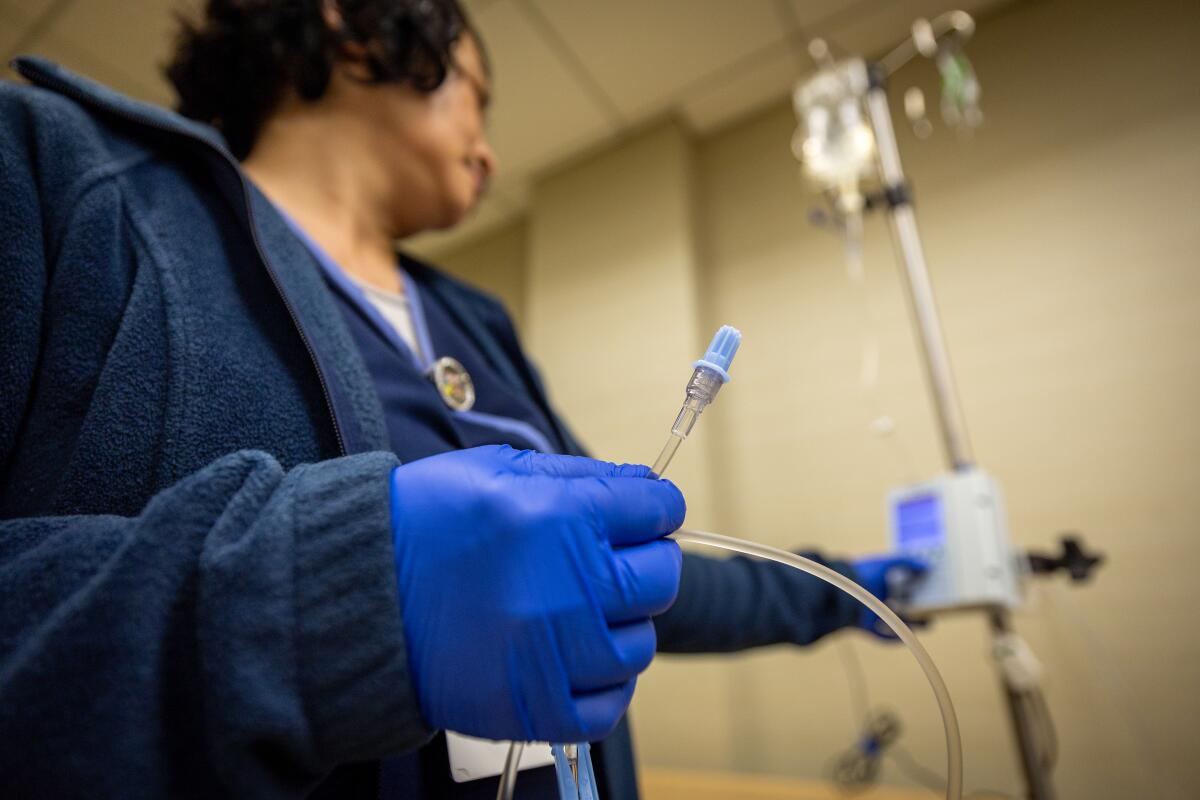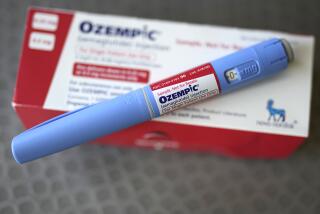Alzheimer’s drug’s potentially fatal side effect, ARIA, obscured by ‘soothing acronym,’ doctors say

Seventy-nine-year-old Genevieve Lane volunteered to take the Alzheimer’s drug Leqembi in a clinical trial because she was forgetting words and misplacing her keys.
Infusions of the drug gave her headaches so severe they sent her to bed. A week after the third dose, she was at a restaurant with her best friend when her speech slurred and she had a seizure. Five days later she was dead.
An autopsy found that Lane died of a mysterious side effect that has a name that sounds as if it might be part of an Italian opera, but has doctors on edge.
The complication called ARIA has nothing to do with music. It is a term adopted by an influential group of pharmaceutical executives and academic scientists to describe potentially fatal bleeding and swelling in the brain caused by drugs like Leqembi.
“Mom believed the drug would help slow progression of her memory problems or do nothing,” said Lane’s daughter, Yvonne Battaglia. “She didn’t know it might kill her.”

Lane’s death, and that of two other trial participants, has raised concerns among some doctors, who question whether Leqembi’s risks are worth its benefits, particularly for the population of older adults it was approved for.
Some of these doctors are urging that a new name be given to the drug’s potential side effects to better alert healthcare professionals to its risks.
ARIA is short for “amyloid-related imaging abnormalities,” with imaging referring to the MRI scans needed to find the brain bleeding and swelling.
“Clearly, it is more than just an imaging abnormality,” said Dr. Matthew Schrag, a Vanderbilt University neurologist who helped with an autopsy that concluded Lane died of brain swelling and bleeding that was probably caused by Leqembi.
“My feeling is that ARIA is too euphemistic of a term. It conveys that this isn’t serious, and it certainly can be,” he said.
Leqembi, known generically as lecanemab, is a monoclonal antibody that works to remove a protein called amyloid from the brain. It received full Food and Drug Administration approval in July.
Eisai, a Japanese drugmaker that has partnered with Biogen, is promoting Leqembi to doctors and people concerned about their memories.
“Get ahead & stay ahead for longer,” an Eisai website says about the drug. It also says that “ARIA usually occurs early in treatment and is usually asymptomatic, although serious and life-threatening events rarely can occur.”
In a recent article, a Stanford neurologist and his colleagues detailed their concerns about ARIA, which they called a “soothing acronym” for brain bleeding and swelling.
“It does certainly have the ring of something that a pharmaceutical company or public relations person would come up with,” Dr. Michael Greicius said in an interview.
Leqembi is approved for mild dementia and a diagnosis known as mild cognitive impairment, in which patients have more memory problems than others their age but can compensate and continue their daily activities.
People with MCI have been found to be at greater risk for developing dementia, but in many cases their memory problems stay the same or even improve.
The FDA has required that the company warn doctors about ARIA. The agency says the condition, which affected more than 20% of those taking the drug in a large trial, can be managed by requiring patients to get repeated MRI scans to look for bleeding and swelling.
“The FDA maintains that the benefits of Leqembi outweigh its risks when used according to the approved labeling,” said Dr. Teresa Buracchio, director of the FDA’s neuroscience office.
Libby Holman, an Eisai spokesperson, called ARIA “globally established nomenclature.”
Because of the risk of ARIA, some Los Angeles medical centers are taking extra precautions.
At Keck Medicine of USC, a neurologist is available 24/7 to take calls from families of those taking Leqembi, since a headache or sudden confusion can be a sign of ARIA, said Dr. Helena Chui, chair of the neurology department.
At UCLA and Cedars-Sinai Medical Center, warnings pop up in a patient’s electronic health record to ensure that all medical staff know the patient is taking Leqembi, because it can interact with certain other medications to make brain bleeding far worse.
And at all three medical centers it takes more than a single doctor to prescribe the drug. Each patient’s case must be reviewed by a panel of doctors and other staff — similar to how complex cancer cases are evaluated.
“We want to keep safety first,” said Dr. Keith Vossel, a professor of neurology at UCLA. “This is the most complicated, complex drug that we’ve prescribed in the dementia field.”
Other physicians say they won’t prescribe the drug.
“If there was a medication that worked, I would be the first person to use it,” said Dr. Clifford Sigel, a neurologist in Santa Monica. “But I won’t be using this in my practice.”
He pointed to a large clinical trial of Leqembi that led to its approval. It found that patients who took the drug saw their memory decline 27% more slowly — or less than half a point on an 18-point cognitive scale — than their counterparts who took a placebo. Sigel and other doctors doubt patients or their families would notice the difference.
Eisai’s Holman disputed claims that the drug does not work. She noted that a panel of outside experts convened by the FDA had voted unanimously that trial data confirmed its clinical benefit.
The name ARIA traces to July 2010 when “turmoil ensued” at an international scientific conference that the Alzheimer’s Assn. holds each year, according to an article by two scientists working in the field.
The FDA had proposed that companies testing new anti-amyloid drugs exclude any volunteer from clinical trials who had more than two brain microbleeds, according to an Alzheimer’s Assn. report. The tiny hemorrhages are sometimes found in healthy people and those with Alzheimer’s or other illnesses.
The agency also said it would require any volunteer who experienced a brain microbleed during the clinical trial to cease taking the drug.
The companies and academics working on the trials viewed the new FDA requirements as “excessively restrictive,” said the report by the association, a nonprofit that has become a powerful force in dementia science.
The industry and academic scientists feared the FDA proposal would stall research on the experimental drugs, the report said, and limit their use.
The drug companies asked the association to debate the FDA’s guidance at its Research Roundtable. Pharmaceutical and medical testing companies can become members of the roundtable by paying the association a $50,000 annual fee.
The association said that “one key question” taken up by the roundtable was whether ARIA was a temporary symptom of the new drug — much the way nausea and hair loss are side effects of chemotherapy — or evidence that anti-amyloid medicines may have more serious adverse effects. That question was never settled.
“Current knowledge doesn’t provide definitive answers to this critical question,” the association said in the 2011 report explaining the roundtable’s work.
Despite the unknowns, the roundtable proposed that volunteers be allowed into the trials even if they had as many as four brain microbleeds. The group said volunteers could keep getting the drug infusions if they developed brain bleeding as long as they did not have significant worsening of symptoms such as headaches and confusion.
The roundtable also proposed calling the brain bleeding and swelling ARIA.
The FDA “subsequently revised and updated the original advice … in a manner consistent” with the roundtable’s suggestions, wrote three of its members.
“Scientific evidence at the time led the work group to propose excluding people who have four or more microbleeds from clinical trials,” the association told The Times in a statement. “The FDA agreed.”
The association declined to answer questions on whether the name ARIA should be changed.
An FDA official told The Times that the industry group’s advice was just one of the factors the agency considered before it revised its 2010 guidelines.
More than a decade later, little more is known about why ARIA occurs or how to recognize it.
One problem is that a patient with ARIA can look like they’re having a stroke. And when stroke patients are taken to an emergency room, the first treatment doctors often consider is a clot-dissolving medicine called tPA, which can make brain bleeding worse.
That’s what happened to a 65-year-old woman taking Leqembi in a trial who arrived at a Chicago ER with stroke-like symptoms, according to a report published in February 2023. Doctors gave her tPA.
“As soon as they put it in her, it was like her body was on fire,” the woman’s husband said in a news story in the journal Science. “She was screaming, and it took like eight people to hold her down.”
The woman died, and an autopsy showed extensive bleeding in her brain, leading doctors to conclude the combination of the two drugs may have caused her death.
Knowing about that risk, Southern California doctors have been teaching emergency room staff to find out whether patients thought to be suffering a stroke may be taking Leqembi.
“We’ve had to train and discuss this with the ER, the neuroradiology team and urgent care,” said Dr. Sarah Kremen, who leads Cedars-Sinai’s Alzheimer’s clinical trial program. “You must ask this person, ‘Are you taking this medication?’”
An FDA database that collects reports of adverse drug reactions from doctors and others shows 23 deaths of patients taking Leqembi.
Holman at Eisai said it would be incorrect to assume the deaths were caused by Leqembi. She noted that Alzheimer’s patients have a higher risk of death because of the natural course of the disease.
In the large trial, less than 1% of patients died — the same rate whether they were taking the drug or the placebo.
Buracchio at the FDA said the agency takes “all adverse event reports seriously.” But she said the agency’s evaluation of the reports “must take the treated population into account,” which in this case is typically older or elderly adults.
To teach doctors about ARIA, Eisai created a website called understanding- aria.com. It tells doctors that ARIA “usually resolves without intervention or treatment modification.”
In a brochure for healthcare providers, Eisai assures physicians that infusions may continue if an MRI turns up evidence of microbleeds as long as there are four or fewer and that the discomfort doesn’t disrupt the patient’s activities.
For Genevieve Lane, an MRI discovered four brain microbleeds before she started taking Leqembi in the trial.
After Lane died, an autopsy found more than 30 microbleeds in her brain, including some that could not be seen on the MRI, according to a report in Nature Communications.
The report’s authors, who included Schrag at Vanderbilt, questioned whether the pre-treatment limit of four brain microbleeds was stringent enough and called for higher standards.
The FDA told The Times that the agency had reviewed the available data and had not identified a specific number of preexisting microhemorrhages that would make it unsafe for patients to take anti-amyloid drugs like Leqembi.
“However, we will continue to monitor the accruing safety data,” the agency said.
Other doctors have questioned what happens to the memories of those who suffer ARIA, even if the bleeding and swelling appear to resolve.
Dr. Madhav Thambisetty, a senior researcher at the National Institute on Aging, said he was concerned by a report in a French medical journal about two women with mild dementia who experienced serious ARIA during a trial. One suffered severe seizures; 11 months later, her memory score dropped by nine points on a 30-point scale. The other patient developed a brain bleed described as “massive”; she lost a significant part of her vision, and her memory score declined by 12 points on the same scale.
An FDA scientist reviewing reports of patients who suffered high numbers of microbleeds in the clinical trial also noted the possible harm to their cognition in her January 2023 report on Leqembi.
One of the patients that Dr. Deniz Erten-Lyons pointed to was a 68-year-old man who had four microbleeds before starting the infusions. After treatment, he began to lose his vision and was hospitalized because of a seizure. An MRI found 96 microbleeds.
Thambisetty said he and Dr. Rob Howard of University College London wrote to Eisai last year to request information about what happened to the cognition of those who suffered ARIA in trials.
Eisai has not responded to their request, he said.
“I’m concerned about the lack of full and transparent reporting,” Thambisetty said. “It’s really important to know what happens to these patients.”
Holman said the company’s analysis of trial data showed that ARIA did not affect cognition.
“Eisai is transparent,” she said. The company follows guidelines for sharing clinical data established by PhRMA, the industry trade association, Holman said.
Greicius, the Stanford professor, also asked Eisai for trial data that would break down results for each volunteer to better understand ARIA and whether patients benefited as more amyloid was removed from their brains.
The response from Eisai, he said, was, “Thanks for your interest, but we can’t release the data.”







